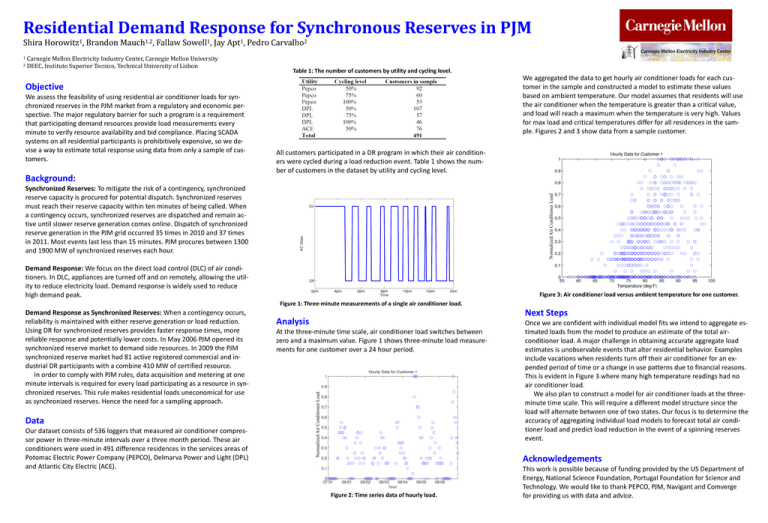Residential Demand Response for Synchronous Reserves in PJM Shira Horowitz
advertisement

Residential Demand Response for Synchronous Reserves in PJM Shira Horowitz1, Brandon Mauch1,2, Fallaw Sowell1, Jay Apt1, Pedro Carvalho2 Carnegie Mellon Electricity Industry Center, Carnegie Mellon University 2 DEEC, Instituto Superior Tecnico, Technical University of Lisbon 1 Table 1: The number of customers by utility and cycling level. We aggregated the data to get hourly air conditioner loads for each customer in the sample and constructed a model to estimate these values based on ambient temperature. Our model assumes that residents will use the air conditioner when the temperature is greater than a critical value, and load will reach a maximum when the temperature is very high. Values for max load and critical temperatures differ for all residences in the sample. Figures 2 and 3 show data from a sample customer. Objective We assess the feasibility of using residential air conditioner loads for synchronized reserves in the PJM market from a regulatory and economic perspective. The major regulatory barrier for such a program is a requirement that participating demand resources provide load measurements every minute to verify resource availability and bid compliance. Placing SCADA systems on all residential participants is prohibitively expensive, so we devise a way to estimate total response using data from only a sample of customers. Background: All customers participated in a DR program in which their air conditioners were cycled during a load reduction event. Table 1 shows the number of customers in the dataset by utility and cycling level. Normalized Air Conditioner Load Synchronized Reserves: To mitigate the risk of a contingency, synchronized reserve capacity is procured for potential dispatch. Synchronized reserves must reach their reserve capacity within ten minutes of being called. When a contingency occurs, synchronized reserves are dispatched and remain active until slower reserve generation comes online. Dispatch of synchronized reserve generation in the PJM grid occurred 35 times in 2010 and 37 times in 2011. Most events last less than 15 minutes. PJM procures between 1300 and 1900 MW of synchronized reserves each hour. Demand Response: We focus on the direct load control (DLC) of air conditioners. In DLC, appliances are turned off and on remotely, allowing the utility to reduce electricity load. Demand response is widely used to reduce high demand peak. Figure 3: Air conditioner load versus ambient temperature for one customer. Figure 1: Three-minute measurements of a single air conditioner load. Data Our dataset consists of 536 loggers that measured air conditioner compressor power in three-minute intervals over a three month period. These air conditioners were used in 491 difference residences in the services areas of Potomac Electric Power Company (PEPCO), Delmarva Power and Light (DPL) and Atlantic City Electric (ACE). Next Steps Analysis At the three-minute time scale, air conditioner load switches between zero and a maximum value. Figure 1 shows three-minute load measurements for one customer over a 24 hour period. Normalized Air Conditioner Load Demand Response as Synchronized Reserves: When a contingency occurs, reliability is maintained with either reserve generation or load reduction. Using DR for synchronized reserves provides faster response times, more reliable response and potentially lower costs. In May 2006 PJM opened its synchronized reserve market to demand side resources. In 2009 the PJM synchronized reserve market had 81 active registered commercial and industrial DR participants with a combine 410 MW of certified resource. In order to comply with PJM rules, data acquisition and metering at one minute intervals is required for every load participating as a resource in synchronized reserves. This rule makes residential loads uneconomical for use as synchronized reserves. Hence the need for a sampling approach. Once we are confident with individual model fits we intend to aggregate estimated loads from the model to produce an estimate of the total airconditioner load. A major challenge in obtaining accurate aggregate load estimates is unobservable events that alter residential behavior. Examples include vacations when residents turn off their air conditioner for an expended period of time or a change in use patterns due to financial reasons. This is evident in Figure 3 where many high temperature readings had no air conditioner load. We also plan to construct a model for air conditioner loads at the threeminute time scale. This will require a different model structure since the load will alternate between one of two states. Our focus is to determine the accuracy of aggregating individual load models to forecast total air conditioner load and predict load reduction in the event of a spinning reserves event. Acknowledgements Figure 2: Time series data of hourly load. This work is possible because of funding provided by the US Department of Energy, National Science Foundation, Portugal Foundation for Science and Technology. We would like to thank PEPCO, PJM, Navigant and Comverge for providing us with data and advice.







